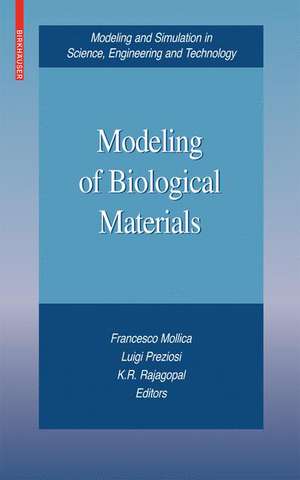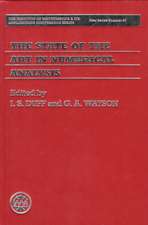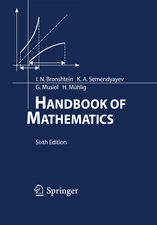Modeling of Biological Materials: Modeling and Simulation in Science, Engineering and Technology
Editat de Francesco Mollica, Luigi Preziosi, K. R. Rajagopalen Limba Engleză Hardback – 4 apr 2007
Din seria Modeling and Simulation in Science, Engineering and Technology
-
 Preț: 410.88 lei
Preț: 410.88 lei - 18%
 Preț: 958.38 lei
Preț: 958.38 lei - 18%
 Preț: 784.13 lei
Preț: 784.13 lei - 15%
 Preț: 551.02 lei
Preț: 551.02 lei - 15%
 Preț: 642.68 lei
Preț: 642.68 lei -
 Preț: 392.60 lei
Preț: 392.60 lei -
 Preț: 388.34 lei
Preț: 388.34 lei - 18%
 Preț: 950.03 lei
Preț: 950.03 lei - 15%
 Preț: 643.84 lei
Preț: 643.84 lei - 15%
 Preț: 649.39 lei
Preț: 649.39 lei - 15%
 Preț: 644.18 lei
Preț: 644.18 lei - 20%
 Preț: 651.57 lei
Preț: 651.57 lei - 18%
 Preț: 1238.42 lei
Preț: 1238.42 lei - 15%
 Preț: 639.25 lei
Preț: 639.25 lei -
 Preț: 399.12 lei
Preț: 399.12 lei - 15%
 Preț: 650.19 lei
Preț: 650.19 lei -
 Preț: 387.58 lei
Preț: 387.58 lei -
 Preț: 392.97 lei
Preț: 392.97 lei -
 Preț: 396.24 lei
Preț: 396.24 lei - 15%
 Preț: 661.32 lei
Preț: 661.32 lei -
 Preț: 396.24 lei
Preț: 396.24 lei - 18%
 Preț: 943.88 lei
Preț: 943.88 lei - 18%
 Preț: 1386.17 lei
Preț: 1386.17 lei - 15%
 Preț: 648.42 lei
Preț: 648.42 lei - 15%
 Preț: 648.24 lei
Preț: 648.24 lei -
 Preț: 405.06 lei
Preț: 405.06 lei - 15%
 Preț: 641.38 lei
Preț: 641.38 lei - 15%
 Preț: 649.71 lei
Preț: 649.71 lei - 18%
 Preț: 1220.88 lei
Preț: 1220.88 lei - 15%
 Preț: 640.06 lei
Preț: 640.06 lei - 18%
 Preț: 952.26 lei
Preț: 952.26 lei - 15%
 Preț: 640.88 lei
Preț: 640.88 lei -
 Preț: 383.50 lei
Preț: 383.50 lei - 18%
 Preț: 1232.26 lei
Preț: 1232.26 lei - 15%
 Preț: 644.49 lei
Preț: 644.49 lei - 15%
 Preț: 655.60 lei
Preț: 655.60 lei -
 Preț: 400.26 lei
Preț: 400.26 lei - 23%
 Preț: 657.13 lei
Preț: 657.13 lei
Preț: 1102.82 lei
Preț vechi: 1160.86 lei
-5% Nou
Puncte Express: 1654
Preț estimativ în valută:
211.04€ • 219.00$ • 176.40£
211.04€ • 219.00$ • 176.40£
Carte tipărită la comandă
Livrare economică 15-29 martie
Preluare comenzi: 021 569.72.76
Specificații
ISBN-13: 9780817644109
ISBN-10: 0817644105
Pagini: 357
Ilustrații: XVI, 358 p. 71 illus.
Dimensiuni: 155 x 235 x 23 mm
Greutate: 0.63 kg
Ediția:2007
Editura: Birkhäuser Boston
Colecția Birkhäuser
Seria Modeling and Simulation in Science, Engineering and Technology
Locul publicării:Boston, MA, United States
ISBN-10: 0817644105
Pagini: 357
Ilustrații: XVI, 358 p. 71 illus.
Dimensiuni: 155 x 235 x 23 mm
Greutate: 0.63 kg
Ediția:2007
Editura: Birkhäuser Boston
Colecția Birkhäuser
Seria Modeling and Simulation in Science, Engineering and Technology
Locul publicării:Boston, MA, United States
Public țintă
ResearchCuprins
Rheology of Living Materials.- Biochemical and Biomechanical Aspects of Blood Flow.- Theoretical Modeling of Enlarging Intracranial Aneurysms.- Theoretical Modeling of Cyclically Loaded, Biodegradable Cylinders.- Regulation of Hemostatic System Function by Biochemical and Mechanical Factors.- Mechanical Properties of Human Mineralized Connective Tissues.- Mechanics in Tumor Growth.- Inhomogeneities in Biological Membranes.
Textul de pe ultima copertă
This interdisciplinary collection of surveys highlights the central role played by the mathematical modeling of mechanical properties having an effect on the biology, chemistry, and physics of living matter. One of the main goals of the book is to present—in a single, self-contained resource—topics that are widely scattered across the literature in a variety of journals having mutually nonintersecting communities of readers, such as applied mathematicians, engineers, biologists, and physicians.
Readers coming from diverse backgrounds are provided with basic modeling ideas and tools to address important problems in the medical and health sciences. Presented are appropriate models as well as their implementation through numerical and computer simulations, which may lead to potential technological innovations useful in medicine. Models are tested in realistic experiments, results are extracted analytically or numerically, and the success of the developed models is determined by comparing theoretical predictions and actual experimental findings.
Written in a user-friendly style that avoids cumbersome mathematical techniques and notation, each chapter examines theoretical and practical issues associated with a specific biomedical application
Specific topics covered include:
* mechanical properties of biological materials—macroscopic and microscopic perspectives
* biochemical and biomechanical aspects of blood flow
* formation and growth of intracranial aneurysms
* modeling of natural tissue substitutes, including cardiovascular and biodegradable stents
* regulation of hemostatic system function
* mechanical properties of tumors, bones, and cell membranes
Modeling of Biological Materials may be used in interdisciplinary, introductory courses covering various biomechanical topics for graduate students in applied mathematics, engineering, and biomedicine. The surveysfeatured in the book will also be a lasting and valuable reference for a wide community of researchers, practitioners, and advanced students in the above-mentioned fields.
Readers coming from diverse backgrounds are provided with basic modeling ideas and tools to address important problems in the medical and health sciences. Presented are appropriate models as well as their implementation through numerical and computer simulations, which may lead to potential technological innovations useful in medicine. Models are tested in realistic experiments, results are extracted analytically or numerically, and the success of the developed models is determined by comparing theoretical predictions and actual experimental findings.
Written in a user-friendly style that avoids cumbersome mathematical techniques and notation, each chapter examines theoretical and practical issues associated with a specific biomedical application
Specific topics covered include:
* mechanical properties of biological materials—macroscopic and microscopic perspectives
* biochemical and biomechanical aspects of blood flow
* formation and growth of intracranial aneurysms
* modeling of natural tissue substitutes, including cardiovascular and biodegradable stents
* regulation of hemostatic system function
* mechanical properties of tumors, bones, and cell membranes
Modeling of Biological Materials may be used in interdisciplinary, introductory courses covering various biomechanical topics for graduate students in applied mathematics, engineering, and biomedicine. The surveysfeatured in the book will also be a lasting and valuable reference for a wide community of researchers, practitioners, and advanced students in the above-mentioned fields.
Caracteristici
A single, self-contained resource for topics that are widely scattered across the literature in a variety of journals having mutually nonintersecting communities of readers, such as applied mathematicians, engineers, biologists, and physicians Provides readers from diverse backgrounds with basic modeling ideas and tools, which address important problems in the medical and health sciences Topics covered include mechanical properties of biological materials, biochemical and biomechanical aspects of blood flow, formation and growth of intracranial aneurysms, and regulation of hemostatic system function Models tested in realistic experiments are presented with implementation through numerical and computer simulations, which may lead to potential technological innovations useful in medicine May be used in interdisciplinary introductory courses covering various biomechanical topics for graduate students in applied mathematics, engineering, and biomedicine












